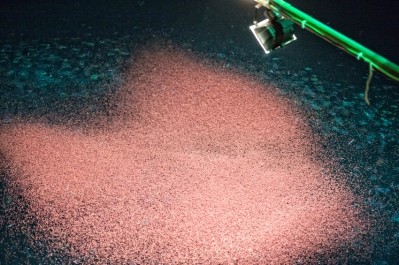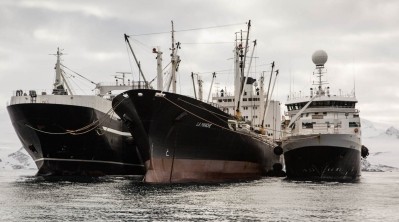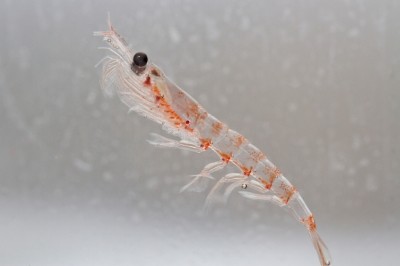Climate change could be affecting krill biomass, but experts say more data needed to make connection

The Frontline segment, titled “Mystery Beneath the Ice” first aired in late January on US public television. According the producers of the show, “the population of krill continues to crash for reasons that baffle the experts.” One researcher quoted in the show said populations declines of “as much as 90%” have been observed in some areas.
Filling in the life cycle
In the show a team of researchers ventured beneath the sea ice to observe how newly hatched krill larvae survive and grow during the austral winter when little or no sunlight reaches the ocean’s surface, meaning there is no phytoplankton to feed on. The growing animals survive in large part by grazing on organic particles trapped in the ice as it freezes. Thus, climate change that affects the amount of sea ice and when it forms were postulated as a possible mechanism for the purported declines in the overall krill biomass.
Determining whether krill are in fact in decline is not easy, experts have said. The region is remote and often has extreme weather, making data collection both difficult and expensive. And methods are still evolving. Sonar surveys have become more reliable and statistical analytical methods such Stochastic Borne Wave Approximations enable researchers to derive more information from them, such as being able to make an informed guess about the health of the individual animals from a cloudy sonar return. But still it’s a far cry from counting caribou in the Arctic.
“Assessing the level of the krill biomass is one of the hot potatoes in Antarctic research,” Rudolfo Werner, a marine biologist with the newly formed Antarctic Ecosystem Research Fund, told NutraIngredients-USA. “When you look at the circumpolar amount of krill, it’s a huge number, but that’s based on some estimates using older data.”
As researchers are often wont to do, Werner said there is a crying need for more data and more up-to-date data. Aker BioMarine, the world’s largest krill harvester, has a record of supporting Antarctic research. It hosts researchers on its two vessels and makes data available from its operations to other researchers and it supports the group Werner works with. Werner said while that is welcome, Aker's data pertains only to where its boats have been. What is really called for is another wide-ranging population assessment. That data could help inform the decisions of Commission for the Conservation of Antarctic Marine Living Resources (CCAMLR), the body that governs human use of Antarctic biomass.
“The last big assessment that was done looked at the four harvesting areas. That was done in 2000. All the data that CCAMLR is using is based on that assessment,” Werner said.
“Some of the partners of CCAMLR (there are 25 states that form the commission) do their own surveys. The United States for example has done some transects near Palmer Station (on an island off the Antarctic Peninsula). We are pushing to get a better, more up-to-date assessment of krill.”
Key strand of food web
Krill form an extremely important piece of the Antarctic food web. It has been said with little exaggeration that everything in Antarctica, which is devoid of terrestrial plant life, either feeds on krill or feeds on something that feeds on krill. But the krill, while widely distributed, are unevenly distributed. Krill can be found all around Antarctica, but are most prevalent in the far South Atlantic (the Southern Ocean is another name for the far southern regions of the Atlantic, Indian and Pacific Oceans). This is also the region where all of the krill fishing takes place.
And the krill are locally patchy, too. Harvesters such as Aker BioMarine report catching krill in swarms so dense that the sea is tinted red, while at other times the swarms are entirely absent. Werner said this highly localized aspect of krill distribution could be what the researcher who cited the 90% decline was referring to.
“In some areas you can have a decline by an order of magnitude. It’s very difficult to know why,” Werner said. He did, however, say that climate change and changes in ice cover are affecting the krill in a broad sense, a concern that krill company executives echo.
“This is an area that has been impacted by climate change, especially the waters west of the Antarctic Peninsula with a decline in sea ice and so a decrease in krill recruitment,” Werner said. (‘Recruitment’ is a term fisheries researchers use to refer to the number of animals from a given year class that survive into the following year.)
“We were fishing all the way to mid to late October which we’ve never done before because there was so little ice. There were lots of krill, more than we’ve seen before, and then overnight they disappeared,” said Nils Hoem, chief scientist of Norway-based Aker BioMarine.
“With regard to the impact of climate change on krill biomass, at the moment we can only speculate on that,” said John Cameron, managing director at Rimfrost, which also operates a krill harvesting vessel. “But of course its intuitive that if there is a change in sea ice cover that could affect the krill.”
Health of predators
No concern about harvest levels was raised in the TV program. Harvesters such as Aker and Rimfrost have long said the the harvest quotas and trigger levels are pegged at such a small percentage of the overall biomass as to be a drop in the bucket. Nevertheless, Werner said more work could be done to understand the season-by-season health of predator populations as the krill picture changes.
“When you look at a penguin rookery for example, how far down does that rookery need to go before you say you have a problem? You’d have to develop a very rigorous methodology. Right now there is no connection of any management decision with how predators might be doing. We’d like to keep the catch levels very low while CCAMLR gets its act together,” Werner said.
















